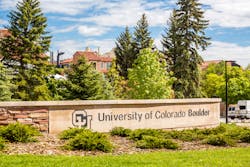How Higher Ed is Reaching for Net Zero
Colleges and universities are setting—and achieving—aggressive sustainability targets on their journey to reach net zero. But how are they reaching these goals—and what challenges are they facing along the way?
BUILDINGS sat down with a panel of experts to discuss the successes and strides this sector is making in sustainability:
- Martha Larson, director of sustainability for RMF Engineering
- Jennifer Cordes, principal at Hord Coplan Macht
- Darrah Jakab, associate principal, sustainable design, at MHTN
Historically speaking, where have colleges and universities landed on the spectrum of the sustainability movement? Would you say they’ve been on the leading edge or lagging behind other sectors—or somewhere in between?
Cordes: I would argue that higher education is on the leading edge, mainly because they haven’t wavered in their goal to battle climate change. A lot of higher education institutions are often restricted in funding, but generally they continue to push themselves to make sustainable solutions happen on their campuses and within their sector of the market.
I think probably the best example is the President’s Climate Commitment. In December 2006, 12 colleges and universities got together and established the American College and University President’s Climate Commitment. They committed to each other that they would work to reduce their greenhouse gas emissions and accelerate research and educational efforts to re-stabilize the Earth’s climate. Now there are 400 colleges and universities that are all signed on to this commitment in all 50 states and the District of Columbia. Together, they represent over 5 million signatories. As a sector, they really believe in this, and that climate commitment has now evolved into the UC3—the University Climate Change Coalition [launched by Second Nature and now complemented by a Resilience Commitment and a Carbon Commitment].
How significant is the environmental footprint that colleges and universities represent as an industry? How critical is it that these institutions begin to curb their energy usage and reduce carbon emissions?
Jakab: As you think about these college campuses, they’re kind of like small cities in and of themselves. As you start to think about the types of buildings that make up these campuses, like labs and highly energy-intensive buildings, it’s critical that these institutions take on this charge that they have and begin to reduce their energy use because they do have significant draws of energy. They have aggressive goals and targets they’re reaching for, but they still utilize a lot of energy. It’s super critical that they understand how they’re actually going to meet their goals. Speaking to the idea of transparency and really being open and honest about how they’re meeting their goals and where they’re falling short is part of that conversation.
Larson: The business model of higher education is set up for this. They are in it for the long haul. The investments they make in buildings and their environment are 100-plus years. As Jennifer mentioned, the President’s Climate Commitment was also very clear about the responsibility. Institutions are responsible for progressing knowledge and moving societal change, and they’re also held accountable for that very visible platform. That commitment really focuses on the obligation of institutions to lead by example, and that’s very much in alignment with progress on fighting climate change.
There are a number of higher education institutions that have made significant commitments to sustainability. What’s driving these institutions to tackle more rigorous sustainability targets?
Larson: It’s multifaceted. There are many ways it comes about. Oftentimes there’s a top-down declaration from leadership, and it’s part of a strategic plan for the campus. It’s part of that particular leader’s legacy, if they choose that to be their legacy at the institution.
It’s also bottom-up. It’s activism. It’s students and faculty saying, ‘This situation is urgent. We have to take action now. We as a community are responsible for demonstrating that we can walk the talk and take action.’ It’s coming from multiple angles.
Are there unique challenges that architects, designers and administrators face when designing or remodeling educational facilities to be healthier and more energy efficient?
Larson: One of the first things that always comes to mind is priorities that are competing for resources, the same pot of money or board engagement and approval. I think the solutions we’re seeing emerging are integrating those goals together. Deferred maintenance for existing buildings is a big challenge for universities, and when they can integrate the ability to upgrade their infrastructure systems to migrate off of fossil fuels, for instance, that can be coupled with the need to renew their infrastructure systems that are now aging and becoming obsolete. Tying various goals together is one way they’re working at that.
The other challenge, in addition to working with existing buildings, is anticipating future needs. I foresee a conversation about, ‘How much should we invest in upgrading the heating system to get off fossil fuels vs., or in addition to, adding air conditioning because our dorms are now unsustainably hot in months when it used to not be so hot?’ These tradeoffs are not only happening in real-time, but we’re also trying to project how those tradeoffs are going to play out in the future given a changing climate.
Cordes: The University of Colorado’s Boulder campus has decided they’re going to electrify their entire campus, so every project has to build the infrastructure for this electrification decision. To Martha’s point, they’re tying together a deferred maintenance program with this long-term goal of electrifying the campus. It’s a great way to think through their long-term goal to get off fossil fuels. We really need to think about it, and higher education institutions are getting pretty smart. Because they do hold these buildings for 100 years, they can think about it in a more progressive way.
Want to hear more? Listen to this episode of the Buildings Podcast!

